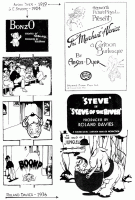The Shadows Move – the 1930s
Almost concurrent with the setting up of Anglia Films a Daily Express newspaper strip cartoonist named Roland Davies thought it would be a good idea to produce a cartoon film series featuring his character ‘Steve the Horses. In 1936 he opened a studio, enlisted the aid of fledgling artists from the Ipswich School of Art, and later took on a young Ronnie Giles.

